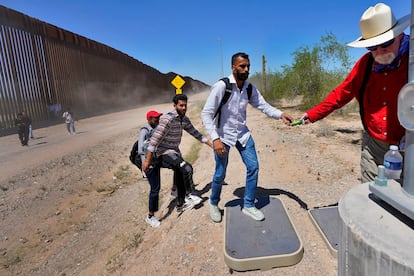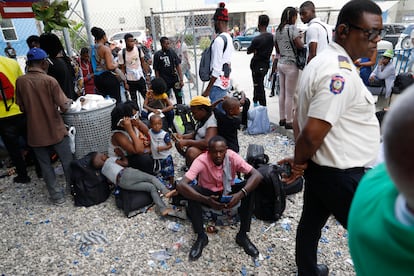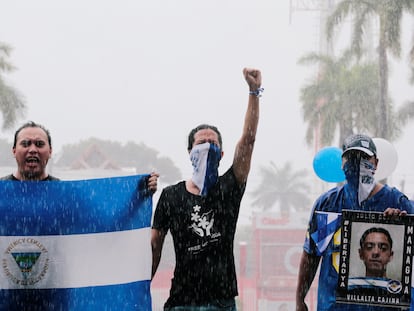Ortega regime turns Nicaragua into gateway for irregular migration to the United States
Over the past 12 months, Managua has received more than 1,000 flights with migrants from countries such as Libya, Morocco, Uzbekistan, India and Tajikistan. Upon landing, they begin different routes to reach the U.S.-Mexico border


In 2021, the Nicaraguan government of President Daniel Ortega and his wife — Vice President Rosario Murillo — opened the doors of the Augusto C. Sandino International Airport to the massive arrival of charter flights. These planes have been transporting new arrivals into Managua, the capital.
The first individuals came from Cuba, the Dominican Republic, El Salvador, Curacao and Haiti. Today, however, there are passengers from countries such as Suriname, Libya, Morocco, Uzbekistan, India and Tajikistan.
For these migrants, Nicaragua is the first stop on their journey to the United States. This arrival point allows them to avoid passing through the dangerous Darién Gap.
According to a calculation by The Inter-American Dialogue — a DC-based think tank — more than 1,000 flights carrying migrants landed in Managua between May 2023 and May 2024.
The majority of the users of this migratory springboard — enabled by the Ortega-Murillo regime — are Cuban and Haitian, or they hail from African and Asian countries. Through an investigation into taxes and unofficial charges, EL PAÍS has discovered that Nicaragua’s ruling Sandinista National Liberation Front (FSLN) has found a lucrative business in the transportation of migrants. However, the United States government has begun to see this flow as a threat to its national security. In November 2023, the State Department launched a new visa restriction policy “against owners, executives, and/or senior officials of companies providing charter flights into Nicaragua designed for use primarily by irregular migrants to the United States.”
Washington’s policy was expanded in February 2024, due to the “growing trend [of] charter flight companies [that] have been offering flights and charging extortion-level prices.” If the restrictions previously only applied to air transportation, from that month onwards, the Biden administration also applied them to sea and land transportation. And, on June 13, the State Department announced that it was imposing visa restrictions on an executive of a charter flight company, without detailing the name of the sanctioned person, nor the company in question.
During the first two weeks of June, U.S. authorities captured eight suspected terrorists from Tajikistan in New York City, Philadelphia and Los Angeles. Sources from the security agencies — cited by NBC News — claim that the detainees have possible links with the terrorist organization Islamic State (ISIS). But the most striking thing about the case is that the alleged suspects entered North American territory through the southern border during the year 2023.
Human-trafficking?
The Ortega regime has ignored warnings from Washington and continues to engage in human-trafficking. Manuel Orozco — a migration expert and analyst at The Inter-American Dialogue — tells EL PAÍS that he has managed to track 1,150 charter and “pseudo-commercial” flights landing in Managua between May 2023 and May 2024. He estimates that an average of 200 passengers per flight entered through Augusto C. Sandino International Airport: that is, around 200,000 people in that 12-month period.
For example, in less than a month — between May and June 2024 — three charter flights carrying migrants arrived in Managua from Tripoli. The planes — Boeing 777-200s — were operated by the airline Ghadames Air Transport. This company doesn’t offer direct flights to the Nicaraguan capital, meaning that these flights were private. Furthermore, their arrival at the Augusto C. Sandino International Airport was never recorded by the National and International Airport Management Company (EAAI).
Previously, in December 2023, a plane from Dubai — with Managua listed as the final destination — was detained at the Châlons-Vatry Airport, in France. There were 276 passengers of Indian nationality on board, of the total of 303 passengers who planned to land in Managua. The charter was detained by the French authorities, following a complaint about alleged human-trafficking. Twenty-five of the passengers subsequently requested political asylum in France, but two were detained because thousands of dollars in cash and passports belonging to other migrants were found on them. The French authorities’ version of events is that Indian citizens hired smugglers to reach the United States, using Nicaragua as a shortcut.
Apart from Cubans, Haitians and individuals from African nations, in recent months, hundreds of migrants of other nationalities have been seen leaving Managua bound for the southern border of the United States, crossing through Central America. According to data from the National Migration Institute of Honduras (INMH), in 2023 alone, at least 373 citizens of Tajikistan entered Honduran territory through the Nicaraguan border. Between January and May 2024, another 73 Tajiks entered Honduras through the same route. Before 2022, Honduras never registered the entry of any citizens of this nationality.

Orozco explains that another way to visualize or measure the irregular migratory flow is by observing the difference between the numbers of passengers who arrive in Managua and subsequently leave. “The difference is negative,” he notes. “In 2023, 890,000 passengers landed in Nicaragua. [This includes] 650,000 foreign tourists who landed by air. In the same year, 570,000 passengers left. The average stay of an international tourist [in Nicaragua] is seven days. Therefore, there’s a deficit of at least 80,000 people who don’t return [to their home country] by air.”
The migration experts also notes that “more than 890,000 people landed in Nicaragua that same year… a country where emigration is at its highest level.”
Political analysts (consulted by EL PAÍS on the condition of anonymity) agree that the Ortega-Murillo regime is likely part of an international human-trafficking network. Others — such as Arturo McFields, the former Nicaraguan ambassador to the Organization of American States (OAS) — argued in an opinion article that Daniel Ortega “should be listed as being part of an international network of human traffickers.”
“The Nicaraguan dictatorship not only doesn’t stamp the passports [of the migrants]... it doesn’t even provide receipts [for the charges], only accepting cash from irregular migrants. The advertising on social media in Africa and Haiti to travel to the United States via Nicaragua is widespread. This makes us suspect that Ortega isn’t acting alone,” McFields denounced.
“Provoking the United States”
For his part, Orozco states that one of the objectives of the Ortega-Murillo regime is to “provoke the United States” by increasing the burden on U.S. authorities, as an influx of migrants arrive at the southern border. This is a difficult issue for the Biden administration in an election year.
“Ortega said that they were going to send migrants to the United States. So, the motivation is fundamentally political and ideological, due to the hatred that Ortega has for the U.S. Now, the implications are substantial. One of them is the threat to the security of the United States — national security — since the control that Nicaragua has over who is arriving from those [countries] is minimal… they can arrive [in Managua] with false passports, or they can be terrorists,” Orozco explains.
The researcher from The Inter-American Dialogue adds that the U.S. authorities are studying the various options they have before they proceed. One involves taking action that goes beyond the levying of sanctions. “What the U.S. government is trying to determine at this moment is the level of complicity that Nicaragua has in the entire process of [the human-trafficking] business. And, if they detect that Nicaragua isn’t only facilitating charter flights, but also that there’s a national network intended to transfer these people to third countries, then you’re really confirming not only [the co-optation] of a state, but rather a criminal state that’s very efficient,” Orozco argues.
When irregular migrants enter the Augusto C. Sandino International Airport, officials charge them each an amount of between $150 and $200 (in cash) to allow them entry. However, there’s no paperwork processed for the collection of the fee. Everything is done without leaving behind a record of the payments, according to testimonies collected by EL PAÍS.
Upon leaving the airport, irregular migrants depart for Honduras. A report by the media outlet Divergentes revealed that dozens of taxi drivers gather daily outside the airport terminal, offering to take the new arrivals to Honduras. “$50 and (I’ll) take you to Honduras,” the transporters say, in broken English. The taxi drivers assure EL PAÍS that they operate with the permission of the airport authorities, to whom they pay a fee to operate at the site.
In 2023, the Ortega-Murillo regime collected over 1.6 billion córdobas (equivalent to around $43.5 million) by collecting “fines” from migrants heading to the United States. The de facto fee is hidden under the category of “other service fees.” These fees represented 64.3% of the income of Nicaragua’s General Directorate of Migration and Immigration (DGME) in 2023, according to a report published in April 2024.
The independent Nicaraguan media outlet El Confidencial notes that the DGME has reported a sustained increase in the collections of “other service fees.” No details are offered regarding the origins of these funds.
“This increase has also coincided with the passage of thousands of migrants to the United States, as well as the opening of Nicaragua to citizens of Cuba, Haiti and various African nations, who use the country as a springboard to reach U.S. territory. The 2023 amount represents a record in the collection of these ‘fines.’ It’s also the first time that the [amount] of one billion córdobas ($27 million) was exceeded. In 2022 and 2021, [Nicaraguan authorities] pocketed 966 million and 608 million córdobas, respectively,” the outlet reports.
Sign up for our weekly newsletter to get more English-language news coverage from EL PAÍS USA Edition
Tu suscripción se está usando en otro dispositivo
¿Quieres añadir otro usuario a tu suscripción?
Si continúas leyendo en este dispositivo, no se podrá leer en el otro.
FlechaTu suscripción se está usando en otro dispositivo y solo puedes acceder a EL PAÍS desde un dispositivo a la vez.
Si quieres compartir tu cuenta, cambia tu suscripción a la modalidad Premium, así podrás añadir otro usuario. Cada uno accederá con su propia cuenta de email, lo que os permitirá personalizar vuestra experiencia en EL PAÍS.
¿Tienes una suscripción de empresa? Accede aquí para contratar más cuentas.
En el caso de no saber quién está usando tu cuenta, te recomendamos cambiar tu contraseña aquí.
Si decides continuar compartiendo tu cuenta, este mensaje se mostrará en tu dispositivo y en el de la otra persona que está usando tu cuenta de forma indefinida, afectando a tu experiencia de lectura. Puedes consultar aquí los términos y condiciones de la suscripción digital.
More information
Archived In
Últimas noticias
Most viewed
- Oona Chaplin: ‘I told James Cameron that I was living in a treehouse and starting a permaculture project with a friend’
- Reinhard Genzel, Nobel laureate in physics: ‘One-minute videos will never give you the truth’
- Sinaloa Cartel war is taking its toll on Los Chapitos
- Why the price of coffee has skyrocketed: from Brazilian plantations to specialty coffee houses
- Silver prices are going crazy: This is what’s fueling the rally










































